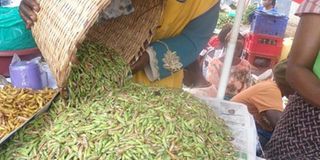As the grasshopper season nears end, prices and demand remain high

In the market, grasshoppers are measured in various quantities and are available as fresh or prepared in different ways. PHOTO BY CHRISTINE KATENDE
Long-horned grasshoppers, commonly known as nsenene in central Uganda, are not only a delicacy but an important source of income.
Although most people pick them from the bushes or other places where they land, those with commercial interests on a wider scale use more efficient means.
They trap the insects by placing metal barrels in different places or by the roadsides; these are fitted with aluminum sheets near the top. They hang fluorescent electric bulbs above this to lure the grasshoppers.
Since they are a seasonal delicacy with a fairly constant demand, in the market, the price varies depending on how much is invested in gathering them. Also, the time during the season is another factor as well as the quantity.
Keep fresh
Aisha Namugera, who sells nsenene in Kibuye market, says, “Now that the supply is high, I purchase a sack ranging from Shs150,000 to Shs250,000. Because I deal in dressed grasshoppers, I hire other people to pluck off the wings and legs and also to boil or fry them.”
For the nsenene not to go bad, Namugera lays them out on a table under an umbrella to shield them from the sun or rain.
“When plucking off the wings and legs, we leave the antennas to help the insects breath because when they die, they produce a bad odour, which turns away customers because they want them still fresh and alive,” she notes.
Many factors
Rehma Jamilah, who works in the same market, sells live grasshoppers. She links the nsenene prices to costs on electricity, drums, iron sheets and transport that the trappers incur.
“The people who trap the grasshoppers incur a lot of costs including the tips they give to traffic police who keep stopping on the way. That forces them to raise the prices at which a sack is purchased,” she explains.
She adds that there are brokers or middlemen in this business, which contributes to the final prices. “It is hard for customers to know what we go through and how much we invest in getting nsenene to the market,” she notes.
Musa Mukasa, sells tomatoes in Nakasero market but also deals in nsenene when they are in season. He has been doing this for three years and from the proceeds, he bought himself a car.
“I put a freeze the tomatoes business during the musenene month (November) and concentrate on trading the insects for more money given the high market demand,” he says.
High supply, high prices
To avoid middlemen in the business, Mukasa works with his brother, Musisi, based in Masaka, who traps the grasshoppers and directly sells to him.
In the previous nsenene season, Mukasa earned Shs4m. From this season, he has so far saved more than Shs3m from the sales. He sells raw dressed grasshoppers at Shs7,000 a mug.
He notes that the grasshoppers sell highly at the beginning of the season and it is around that period that many traders earn big from the business.
At this point, the grasshoppers are still trickling into the market. A sack is purchased between Shs400,000 and Shs500, 000 and a mug is sold at Shs30,000.
Comparing the last nsenene season with the current one, Namugera explains that this time, the supply is high along with higher prices. Then, a sack cost from Shs70,000 to Shs150,000. Now, the price ranges from Shs200,000 to Shs400,000.




